Kyle City Council will consider passing a new ordinance which would restrict where some individuals on the Texas sex offender registry can reside, regardless of whether or not the offender is on probation or parole.
The ordinance, brought to council by Kyle Police Chief Jeff Barnett, specifically targets offenders convicted of crimes involving minors. Kyle does not have the most sex offenders in the region—New Braunfels has 106—but its ratio to normal residents is greater than many neighboring cities. According to KPD data, there is one registered sex offender for every 843 residents.“We’re really focused on creating what’s identified in the ordinance as child safety zone areas, where families can reside or families can enjoy the parks and other amenities in our community and feel safe,” Barnett said.
A KPD memo attached to the ordinance said offenders are extremely likely to use physical violence and to repeat offenses.
The same memo quotes a report published by the United States’ Office of Sex Offender Sentencing, Monitoring, Apprehending, Registering, and Tracking (SMART), which states 44.3% of child molesters with more than one prior arrest reoffend.
However, the same SMART report also noted “the long-term recidivism rate for child molesters categorized as low risk was less than 20 percent.”
Mary Sue Molnar, chair of nonprofit advocacy group Texas Voices, said the registry is ineffective and hurts community safety. She said residency restrictions such as Kyle’s proposed ordinance are increasingly common, but create their own issues.“It’s displacing a lot of people—people that can really reintegrate and reenter society in a good way,” Molnar said. “We’re just shutting doors on them, just shutting every door we can, which seems like the opposite of what we should be doing.”
Among the key findings in the Department of Justice’s report, “Sex Offender Residency Restrictions: How Mapping Can Inform Policy,” residency restrictions were found to make it difficult or impossible for sex offenders to find housing.
The report states this can lead to sex offenders becoming homeless, which then leads to them becoming more difficult to track and monitor.
The National Institute of Justice also states, “while these laws are popular, there has been very little evidence of their effectiveness in reducing crime.”
The proposed ordinance for Kyle was originally set to restrict registrants from living within 1,500 feet of a child safety zone, which include various types of public and private parks, day-care centers, public and private schools, arcades, and other facilities.The 1,500 foot limit would cover roughly 95% of the city, but City Council may consider the ordinance with a limit of 1,000 feet, which would still sequester much of the city.
Barnett made clear in an interview with Community Impact Newspaper registered residents would not be ejected from their homes. After multiple vote delays, Barnett said language was being changed so that current residents on the registry would not be affected unless they move.
Homeowners on the registry would be allowed to stay if already living in a zone, but they would have to live outside a zone if they decide to move.
Molnar said the ordinance could have a big impact on offenders trying to get back on their feet once released from prison, many of whom move in with a parent or relative.
Barnett suggested families would have to evaluate their commitment to supporting relatives on the registry and could move beyond safety zones.
However, relocation could be cost prohibitive, and without that resource offenders can end up homeless, according to the DOJ.
Barnett expressed sympathy for individuals in such circumstances, but said the focus was on the greater good.Molnar said an additional issue arising from residency restrictions are pocket parks, which are established to create blanketing safety zones to block offenders.“You can turn any corner into a pocket park,” Molnar noted. “It makes their whole city off limits.”
San Antonio resident Tim Sankey, a registered sex offender who lived in Seguin before a similar ordinance was passed, believes perceptions need to change about the registry.
“Most people who are on the registry are just like me,” he said. “They have families, a stable job and want to have a successful and productive life.”
In 2001, Sankey was convicted of a crime with a minor, whom he said misrepresented her age to him and other adult men who were also convicted.A 2020 brief published by the Texas Association Against Sexual Assault reported 93,178 registered sex offenders in the state in 2018. It said housing instability increased the likelihood of sex offenders reoffending.
TAASA’s brief also cited a 2006 story by Minnesota Public Radio, which quotes an Iowa sheriff who said his office went from knowing where 90% of offenders resided to knowing where just 50-55% were located after passing residency restrictions.
The brief also pointed out issues it perceived with the registry, and said it should be limited to high risk individuals, a distinction the Kyle ordinance does not make.
“We’re relying on the state to have established the importance of them being a registered sex offender against a minor at that time,” Barnett said. “We are considering that that meant the community at large needed to be aware of that.”
Molnar said opposition to residency restrictions is rarely successful, but stressed the benefit of providing offenders with a path back into society, as well as the risk posed by casting them out.
“If you don’t have a place to live, you don’t have a job, you don’t have any friends, no family support and you’re living out on the street, what do you have to lose?” she pondered.





